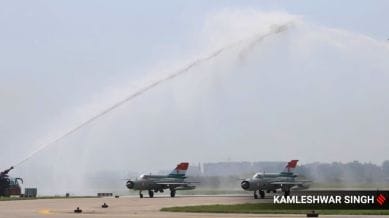Stay updated with the latest - Click here to follow us on Instagram
Air Chief Marshal A P Singh to fly MiG-21 BISON with call sign Badal 3 in final sortie
Among the six pilots who would fly the MiG-21 BISON at the send-off ceremony is Squadron Leader Priya Sharma.

Close to high noon on Friday, MiG-21 BISON will take off, and land for the last time at Air Force Station, Chandigarh. A journey that began more than six decades ago from Chandigarh will end in the same city, and the roar of the MiG-21 will never be heard again.
It was a future air chief, Wing Commander (later Air Chief Marshal) Dilbagh Singh, who led the first MiG-21 Squadron-28, aptly named the ‘First Supersonics’ in this city, then the capital of joint Punjab. More than six decades later, another air chief, Air Chief Marshal A P Singh, will fly the last sortie of No. 23 Squadron with the call sign ‘Badal 3’ on Friday afternoon.
On Wednesday, a full dress rehearsal of the event took place, and everything that will be done on the day the MiG-21s are phased out of service was carried out including a breathtaking display by the Suryakiran aerobatics team, an Akashganga sky diving display, a simulated raid by Jaguar fighter aircraft, and a chase by retiring MiG-21s of the No.23 Squadron ‘Panthers’.
As per the programme announced, Defence Minister Rajnath Singh, Chief of Defence Staff Gen Anil Chauhan, the three service chiefs, six former chiefs of IAF, and all Commander-in-Chiefs of IAF commands will attend the event. The six former IAF chiefs who will attend the ceremony Friday are Air Chief Marshals S Krishnaswamy, A Y Tipnis, S P Tyagi, P V Naik, B S Dhanoa, and R K S Bhadauria.
The six MiG-21s of No. 23 Squadron, which will participate in the final fly past ceremony, will be given a water cannon salute after they land. Among the six pilots is a woman pilot, Squadron Leader Priya Sharma, who also flew in Wednesday’s dress rehearsal.
‘The First Supersonics’
The No. 28 Squadron, which was equipped with the first lot of MiG-21 aircraft, was raised in Chandigarh with Wing Commander (later Air Chief Marshal and Chief of Air Staff), Dilbagh Singh taking over its command on March 2, 1963. Group Captain Trilok Nath Ghadiok, who raised the No. 44 Squadron in Chandigarh in April 1961, was the Station Commander of Air Force Station Chandigarh at the time.
The MiG-21s inducted into the IAF at that time were of the MiG-21 F-13 type, the older version of the aircraft. Seven officers had been selected by the Air headquarters to be sent for training on the MiG-21 in Russia, including Wing Commander Dilbagh Singh, Squadron Leaders MSD Wollen and S K Mehra, and Flight Lieutenants A K Mukherjee, H S Gill, A K Sen, Denzil Keelor and B D Jayal.
While Keelor could not complete the training due to medical reasons, Wollen later succeeded Dilbagh Singh as the Commanding Officer of the squadron and commanded it during the 1965 India-Pakistan war.
Wollen and Mukherjee were in the first MiG-21 crash, which took place near Chandigarh in December 1963, when two of the aircraft collided mid-air while practising for the 1964 Republic Day parade. At the time, no one could have predicted that the MiG-21 and its variants would be in the news for several crashes over the years that killed hundreds of pilots, eventually earning it the pejorative sobriquet ‘The Flying Coffin’.
The first six MiG-21s arrived in Chandigarh in April 1963, after being flown from No. 2 Equipment Depot, Bombay (now Mumbai), to Chandigarh via Agra. They were earlier received in Bombay in a disassembled condition and had been assembled by a team of Soviet engineers, and were test flown by their pilots.
The No. 28 Squadron rightly earned the name of ‘The First Supersonics’ with the induction of the MiG-21s, and has retained that name to date. The unit now flies the MiG-29 aircraft and is stationed in Adampur, Punjab.